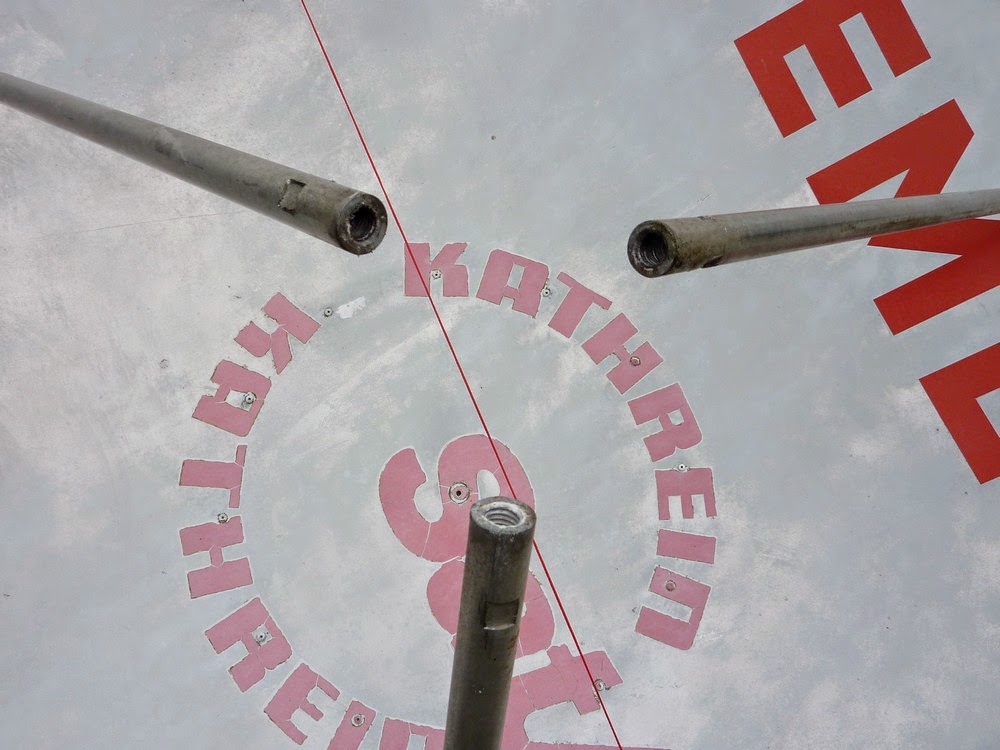(
 The tubular throat pipe of the Invacom ADF-120 feedhorn is threaded to allow the matching scalar rings to be moved ahead of or behind the central throat. The more the protrusion of the throat, beyond the scalar rings, the wider the feedhorn "sees."
The tubular throat pipe of the Invacom ADF-120 feedhorn is threaded to allow the matching scalar rings to be moved ahead of or behind the central throat. The more the protrusion of the throat, beyond the scalar rings, the wider the feedhorn "sees."With a "fast" F/D ratio dish the feedhorn must be even more carefully matched than with "slower" parabolas. The feedhorn must "see" wide enough to capture the vital signal from the very edge of the dish. Where ironically by far the most dish area is situated. Otherwise the feedhorn has effectively reduced the diameter of the dish. If, however, the feedhorn is adjusted to see beyond the edge of the dish it picks up more noise. Which may be just as bad as a weaker but cleaner signal from the (effectively) smaller dish.
The Kathrein 2.2m dish has an F-ratio of 0.34. [75/220cm] Carrying the 0.34 line across the ADF-120 graph to the falling curve suggests ~5.4mm protrusion. At least it does on the ADF-120. Will the F/D 0.38 IRTE feedhorn respond in exactly the same way? The only way to find out is to try:


There are two ways of extending the throat protrusion. The scalar rings could be cut back in the lathe. Or the waveguide throat can be extended with an add-on ring. The first is rather permanent if it fails and leaves the bare edges of the scalar rings open to corrosion unless painted. A press-on throat extension ring is a much simpler matter and has no permanent effect on the feedhorn.
So I made an aluminium extension ring in the lathe to fit on the central throat of the IRTE feedhorn. Making it fairly tight would ensure it would not fall off in its naturally downward facing condition. The situation was slightly complicated by the clear plastic cap on the feedhorn throat. This thin cap is intended to keep insects out. Particularly spiders which might fill the entire length of the waveguide feedhorn and LNB bore with cobwebs. I decided to leave the cap in place and made the bore of the ring the same as the IRTE feedhorn throat.
First I made the "socket" to fit nicely on the feedhorn throat cap. Then I gradually shortened the ring until I measured just over 5 mm to the face of the plastic cap from the front edge of the ring when in place. I turned the outside of the ring to match the diameter of the feedhorn throat.
Now all I need to do is test the modified feedhorn on a real signal. I doubt it will make a dramatic improvement in signal quality but it is easily adjusted for more overhang (protrusion) and instantly removable if it proves to be worthless.
And here is the extension in place on the feedhorn. The internal step at the ring/feedhorn interface is an illusion due to the plastic cap. The bores are carefully matched and fit closely together to avoid any gap.
So much for theory. The results of fitting the extension ring to the IRTE feedhorn were awful! Signal S/Q dropped instantly from 82/56% [bare] to 72/30%. [ring fitted] That was on the 28E Pan-Euro beam. Ouch!
There was the usual No Signal, with or without the extension ring, on the 28E UK Spot Beam after 14.00 pm. [Which was when I first switched on.]
The only hope for improvement, over the bare IRTE feedhorn, is to shorten the extension ring in small steps. Testing at each protrusion length until it has no extra extension left. The IRTE feedhorn has a slight protrusion of the throat pipe. I may have completely overdone things by making the ring extension far too deep/long. I had already turned a mandrel to hold the ring in the lathe so shortening it in (say) millimetre steps between testing will be easy enough.
I will have to wait until tomorrow to have a UK SB signal to test my shortening results. The difference between the F/D minimum of 0.38 (IRTE feedhorn) and the Kathrein dish's 0.34 will probably need only a tiny ring extension. Tomorrow will tell.
After further thought I realised that it is the extension beyond the front surface of the scalar rings which matters. I had used the plastic throat cap as my baseline. Where the IRTE feedhorn throat already has some protrusion. Next step is to cut the ring down in stages to 5.5mm above the scalar rings to match the [F/D 0.34] tuned Invacom.
Click on any image for an enlargement.
(



































